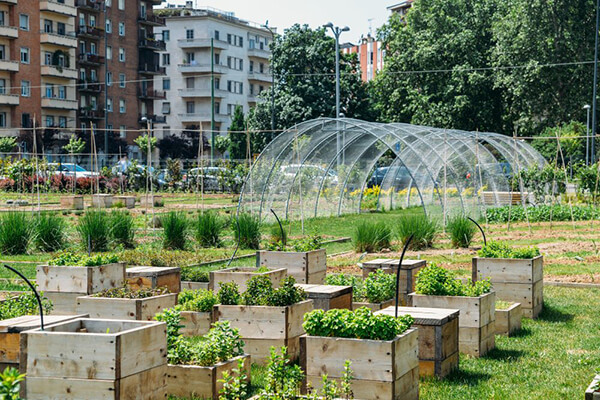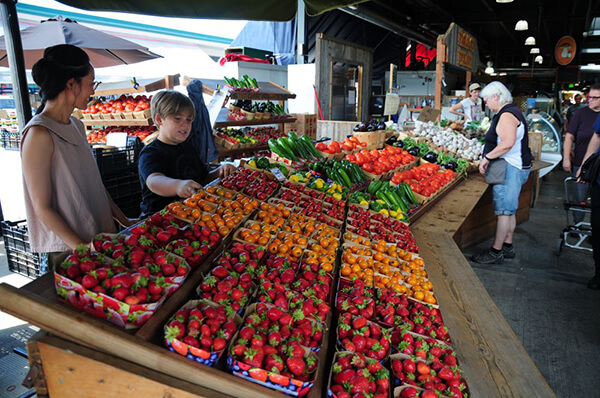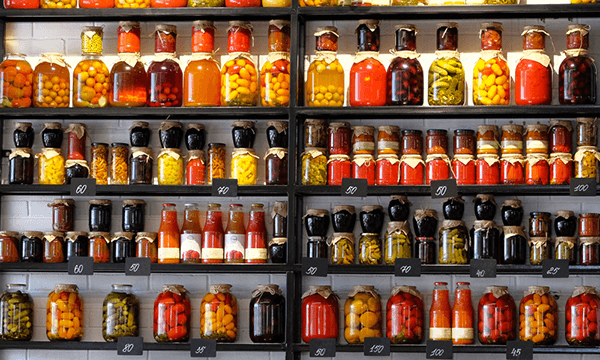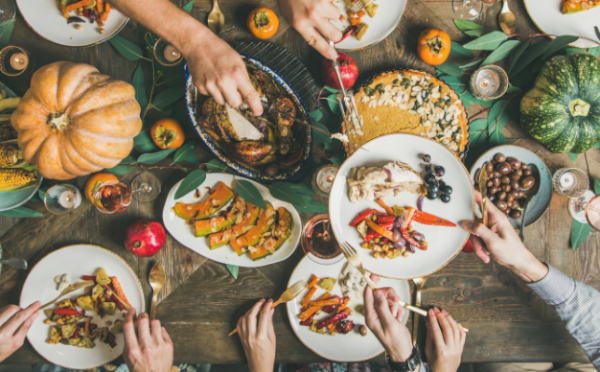Strawberries in December? Pumpkin in March?
Thanks to modern agriculture and distribution methods, we can get virtually any kind of produce we want, from anywhere in the world, at any time of year. Today, a walk through the produce section of a grocery store is like a trip around the world.
But, just a few generations ago, produce was only available in the regions, and during the seasons, in which it could naturally grow. People enjoyed strawberries in the summer and pumpkin in the fall. Period.
Eating seasonally was once a way of life, now it is practically a folk tale.
So, with everything we’ve gained in convenience and accessibility, has anything been lost? There may be some benefits to eating in harmony with the seasons…
Better flavor, and better for you
Have you ever eaten a summer tomato, fresh off the vine? If you have, I’m sure you noticed the stark contrast in flavor to the greenhouse varieties available in grocery stores in January (flown in from Mexico, most likely).
In the U.S., produce grown in North America may spend up to 5 days in transit before arriving at a distribution center. At the grocery store, it may spend another 1–3 days on display before being purchased by a customer, who may store it for up to 7 days before consuming. (1)
In those two weeks from harvest to plate, fruits and vegetables can lose a substantial amount of their nutritional quality, not to mention flavor.
In fact, in just 7 days, vegetables can lose 15 to 77% of their vitamin C content. (2)
When foods are in season and don’t spend a week traveling halfway around the world, they are more nutritious, and simply taste better. And, let’s face it, you are probably more likely to eat your veggies when they actually taste good!

Healthful harmony with nature
In Traditional Chinese Herbalism (TCM), balance and harmony are essential to good health and overall wellbeing. TCM emphasizes the importance of harmonizing your body, mind, and spirit, as well as harmonizing your individual energy with nature. (3)
The food you eat can be a daily connection to (or disconnection from) the energy of nature.
See, according to TCM, foods have unique functions and beneficial supportive properties for specific organs and systems in the body. They also help the body adapt to the physiological impact of changing seasons.
Ever wonder why you crave a hearty beef stew in the winter but lighter, fresher fare in the summer?
It may be because of the yin and yang properties in these foods. Yin and Yang is the concept that everything in the universe contains two opposite yet complementary energies. Foods can have cooling and warming effects on the body depending on how yin or yang they are–yin food is cool and expanding while yang food is warm and contracting. So in the cooler seasons you need warming foods to remain in balance, and vice versa.
It isn’t about the temperature of the food so much as the effects the foods have on your body. Hot tea, for example, can be either warming or cooling, depending on the type of tea (black teas are considered warming whereas green and white teas are cooling).
And, of course, the foods that are naturally abundant in each season tend to have more of the opposing energy you need to remain in balance with nature.
Yin foods (good in hot weather, generate cool energy) include crab, watermelon, most green vegetables, sprouts, cucumber, cherries, strawberries, green and white tea.
Yang foods (good in cold weather, generate warm energy) include land animal protein, eggs, root vegetables, onion, garlic, ginger, hot peppers/spices, black tea.

Easier on your wallet
You’ve heard the old saying, “Time is money?” Well, this applies to food as well.
A major downside of a global food system is the added cost of transportation, storage, labor, and food waste. The more time it takes a food to go from plant to plate, the more expensive that food becomes.
Plus, Economics 101’s concept of supply and demand comes into play here: when foods are in peak growing season, there is naturally more supply, which means a lower cost to you!
Community and connection
In our technology-crazed society, we have become increasingly disconnected from the natural world–and the people–around us. We work, shop, and interact through screens and, thus, no longer rely on direct human contact for most aspects of our daily lives.
Despite near-constant connectivity, many people are feeling more isolated than ever. And it may be affecting our health. Healthier, balanced moods are seen with greater feelings of social connectedness, and strong social ties may increase longevity. (4)
When you eat seasonally, you will likely spend more time shopping farmer’s markets or local co-ops. These tend to be more social environments than grocery store chains. You can take the time to talk with the farmers and learn more about the food you are buying, in addition to making friends with the other patrons.
Seasonal eating can be a powerful way to regain connection, not only with the natural world, but also with the people in your community.

Help the planet
Our global food system is not helping our environment.
There are numerous factors that influence the carbon footprint of food, but generally speaking, the shorter a food has to travel, the better it is for the planet. Transporting food around the world means emissions from planes, trains, and delivery trucks.
Plus, food that is transported long distances is usually packaged in some fashion, if not for retail sale, at least for protection during transit. With so much plastic waste filling overflowing landfills and polluting the oceans, the more each of us can do to avoid unnecessary packaging, the better.
By eating seasonally, you can help support local, sustainable agriculture.
How to eat seasonally
Ready to start living more in-tune with nature? Awesome! Here are a few tips to help you get started with a more seasonal approach to eating…
Learn your local seasons
First, you’ll want to familiarize yourself with your local climate and seasons. Eating seasonally depends on what foods grow best in your climate and during what time of year.
This Seasonal Food Guide is a great resource to find out what foods are in season in your region.
 In North America, these are some fruits and veggies that are commonly available during each season: (5)
In North America, these are some fruits and veggies that are commonly available during each season: (5)
Spring (March, April, May)
Apricots, Artichokes, Asparagus, Broccoli, Butter Lettuce, Chives, Collard Greens, Corn, Fava Beans, Fennel, Honeydew, Limes, Pineapple, Red Leaf Lettuce, Rhubarb, Snow Peas, Spinach, Strawberries, Swiss Chard
Summer (June, July, August)
Apricots, Beets, Bell Peppers, Blackberries, Blueberries, Boysenberries, Butter Lettuce, Cantaloupe, Cherries, Corn, Cucumbers, Eggplant, Figs, Grapefruit, Honeydew Melon, Jalapenos, Lima Beans, Nectarines, Peaches, Plums, Radishes, Raspberries, Shallots, Strawberries, Summer Squash, Tomatoes, Watermelon, Zucchini
Fall (September, October, November)
Acorn Squash, Apples, Broccoli, Brussels Sprouts, Butter Lettuce, Butternut Squash, Cauliflower, Garlic, Ginger, Grapes, Jujube, Kumquats, Mushrooms, Persimmons, Pineapple, Pomegranate, Pumpkin, Sweet Potatoes, Swiss Chard
Winter (December, January, February)
Brussels Sprouts, Collard Greens, Dates, Delicata Squash, Grapefruit, Kale, Kiwifruit, Leeks, Mandarin Oranges, Oranges, Passion Fruit, Pear, Persimmons, Pomegranate, Sweet Potatoes, Tangerines, Turnips
Shop farm-fresh
While some grocery stores do carry local produce, their definition of “local” may be a stretch. Plus, they usually only have a handful of foods to choose from. For the most variety and best quality seasonal produce, try out these great farm-fresh options:
- Your local farmer’s market
- Join a CSA (Community Supported Agriculture)
- Local grocers or co-ops
- Farm-to-you produce delivery services
Stock and store
Of course, just because you eat seasonally doesn’t mean you can’t occasionally enjoy some strawberries in December or pumpkin in July. We don’t want to completely abandon the luxuries of modern living.
If you buy foods when they’re in season and then store them yourself, you will still save money, support local farming, minimize plastic waste, and maximize the nutrient quality of the foods.
You can try your hand at DIY food preserving by freezing, pickling, or canning seasonal foods: freeze pumpkin and butternut squash (cooked and pureed), summer berries, or ice cube trays of fresh herbs (chopped up and mixed with a little water); pickle some beets, cucumbers, or onions; can homemade applesauce.

Plant a garden
It doesn’t get more local, fresh, or in-season than straight from your backyard!
And don’t worry if you live in the city or have limited space, there are some great resources out there for vertical gardens and urban homesteading.
Even if you only have space for a little herb garden, you may find that a constant selection of seasonal herbs really livens up your cooking and helps bring the flavors of the season to every meal.






